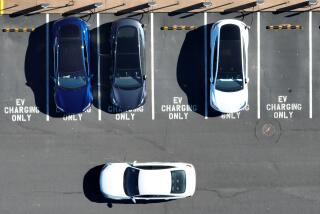Proposed University Given Grant
- Share via
CAMARILLO — Fueled by a grant awarded Tuesday by the county’s Air Pollution Control District, Cal State officials are pushing forward with plans to turn Ventura County’s proposed four-year university into an environmentally friendly “green campus,” with a network of fuel-efficient transportation systems.
The $12,766 grant will pay most of the cost of leasing an electric vehicle and installing a charging station at the developing Cal State Channel Islands campus in Camarillo.
And it represents the first concrete step in an ongoing effort to employ alternative transportation programs to help the university solve anticipated air pollution and traffic problems at the campus, the first phase of which is set to open next fall.
Cal State planners today are expected to submit applications to the Ventura County Transportation Commission for nearly $3 million in federal transportation funds to establish fuel-efficient bus service and other state-of-the-art commuter programs to the university.
The commission is scheduled to decide in March how to spend $19 million set aside for Ventura County under the federal Congestion Mitigation and Air Quality program.
“We’re doing everything we can to minimize pollution and to minimize traffic,” said Noel Grogan, project manager for the proposed university. “This is really the first step in attempting to build a transportation system which we hope down the road will get 40% to 50% of our students to arrive here without using automobiles.”
*
Cal State planners got an early jump last summer, announcing an ambitious proposal to establish nature preserves, swaths of open space and cutting-edge transportation programs at the campus.
Under the so-called green campus proposal, a fleet of energy-efficient buses and other vehicles would be employed to shuttle students to and from the university.
And once there, students would hop electric bicycles or fuel-efficient trams to traverse a 630-acre campus crisscrossed by wildlife corridors and conservation zones.
The decision Tuesday by the Air Pollution Control District will enable CSU officials to lease an electric-powered Toyota RAV4, a sport utility vehicle, as a replacement for a gas-burning vehicle in the university’s fleet.
The Toyota, which could be cruising the campus by year’s end, will serve as a demonstration vehicle for the university’s efforts to employ advanced transportation programs.
Cal State planners have asked the county for more than $100,000 to eventually replace 14 vehicles in the university’s fleet with fuel-efficient ones. That application is scheduled for review by the Air Pollution Control District early next year.
“They certainly seem to be making a commitment to alternative fuels,” said Mike Villegas, a manager with the district.
Looking down the road, Cal State officials today will submit three applications to the county’s transportation commission for federal dollars.
Two of the applications, totaling $2.7 million, are for proposals to create an energy efficient bus system to serve the campus. CSU planners would use the money to buy four compressed natural gas buses and operate the bus system for three years.
University officials also are asking for $99,000 to establish an electric bicycle program that would enable students to commute to the campus from connecting points in Oxnard and Camarillo.
The university’s applications will be considered with many others from around the county in coming months, said Maureen Hooper Lopez, the commission’s director of transit programs.
*
These particular transportation funds are only made available every six years so the competition will be strong, Hooper Lopez said. But she said she expects the Cal State proposals to be strong contenders for a portion of the $19-million pot.
“One selling point for the university is that it is for everyone in this county,” she said. “Although that’s not a particular consideration, when we’re looking at distributing funds we’re definitely looking at what audience is going to benefit.”
If the Channel Islands campus does receive the grant money, it will have to pony up about $480,000 in matching funds. Grogan said that money will be generated by student parking fees when the campus opens its doors.
In the meantime, he said planners will continue to search for ways to beef up transportation programs.
In partnership with Burbank-based CALSTART, a transportation consortium that earlier this year established an office at the Camarillo campus, Grogan said the university is in a unique position to work out traffic problems, even if it means employing somewhat unconventional methods, such as electric bicycles, for getting people from one place to another.
“Some of these things are going to work really well and some of them are going to need some work,” he said. “Certainly it gives us the opportunity to try a whole bunch of things that wouldn’t normally be tried.”
More to Read
Sign up for Essential California
The most important California stories and recommendations in your inbox every morning.
You may occasionally receive promotional content from the Los Angeles Times.










